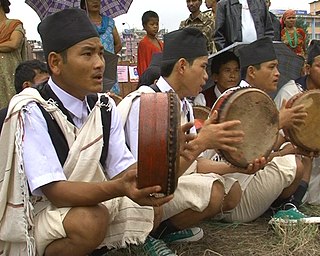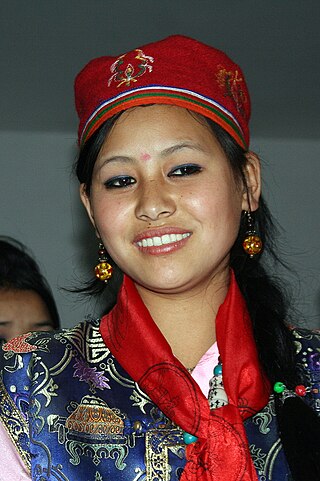
Owing to India's vastness and diversity, Indian music encompasses numerous genres in multiple varieties and forms which include classical music, folk, rock, and pop. It has a history spanning several millennia and developed over several geo-locations spanning the sub-continent. Music in India began as an integral part of socio-religious life.
Music of Nepal refers to the various musical genres played and listened to in Nepal. With more than fifty ethnic groups in Nepal, the country's music is highly diverse. Genres like Tamang Selo, Chyabrung, Dohori, Adhunik Geet, Bhajan, Filmi music, Ghazal, Classical music, songs and Ratna music are widely played and popular, but many other less common genres are yet to be cataloged. Western musical genres like Rock, Metal, Hip-Hop, Rap, R&B also regularly feature on the Nepalese music charts. Most of the country's musical bands are based in the Kathmandu valley. Musical genres from Tibet and India have greatly influenced Nepalese music.

The Tamang, are a Tibeto-Burman ethnic group of Nepal, Southern Bhutan and North India. In Nepal, Tamang/Moormi people constituted 5.6% of the Nepalese population at over 1.3 million in 2001, increasing to 1,539,830 as of the 2011 census. The Tamang people are concentrated in the central hilly region of Nepal. Indian Tamangs are found in significant numbers in the state of Sikkim and the districts of Darjeeling and Kalimpong in West Bengal state. Bhutanese Tamangs are native to various districts in the southern foothills of the Kingdom of Bhutan. Such districts include the Tsirang District, the Dagana District, the Samtse District, the Chukha District, the Sarpang District and the Samdrup Jongkhar District. Tamang language is the fifth most-spoken language in Nepal.

Indian folk music is diverse because of India's enormous cultural diversity. It is sung in various languages and dialects throughout the length and breadth of this vast nation and exported to different parts of the world owing to migration.

A damphu, or damfoo, is a percussion instrument similar to a large tambourine. This instrument is used by the Tamang people of Nepal to play the melodious Tamang Selo. According to folklore Damphu was invented by Peng Dorje, a Tamang King and named it after Nepal's national bird the Daphne bird.

The Nepali Sarangi is a Nepali folk instrument. It is a chordophone played by bowing. Traditionally in Nepal, the Sarangi was only played by people of Gandarbha or Gaine caste, who sing narrative tales and folk song, however, in present days, its popularity extends beyond the Gandharba community and is widely used and played by other caste members as well. It has also garnered much interest in other music genres, such as Nepali rock and film music. While the Sarangi has become the quintessential Gandharba instrument, while its counterpart, the arbajo, which is a plucked lute, has fallen into obscurity.

Hira Devi Waiba was an Indian folk singer in the Nepali-language and is hailed as the pioneer of Nepali folk songs.

Indian Gorkhas, also known as Indian Nepalis, are an ethno-cultural group native to India, who speak Nepali as a common language. They inhabit mainly the states of Sikkim, West Bengal, Northeast and Uttarakhand, including their diaspora elsewhere in India and abroad. The modern term "Indian Gorkha" is used to differentiate the Nepali language Speaking Indians from Nepalis.

Kutumba is an instrumental folk Nepalese band. It only uses Nepalese traditional musical instruments such as bamboo flutes, sarangi, madal, tungna, dhol, jhyamta, arbajoo, dhime, dhyangro, damphu, khin, and singing bowl. The band recorded a single for season 6 of Coke Studio Pakistan, which aired in late 2013. They have collaborated with other Nepali artists such as Navneet Aditya Waiba, Satya Aditya Waiba, Albatross, Hari Maharjan, 1974 AD and Astha Tamang Maskey. They competed in the AI Song Contest 2021 alongside Diwas, Chepang, and Hari Maharjan with the song "Dreaming of Nepal", placing 17th with 15 points.

The dhyāngro is a frame drum played by the jhakri (shamans) of Nepal and India—especially those of the Magars, the Kirati, and the Tamang—as well as by Tibetan Buddhist musicians.

Navneet Aditya Waiba is an Indian singer who primarily sings in Nepali-language and the daughter of the late Hira Devi Waiba, the pioneer of Nepali folk music. Navneet and younger brother Satya Aditya Waiba (producer/manager) are the only artists in the Nepali folk music genre who sing and produce authentic traditional Nepali folk songs without adulteration or modernisation using mostly organic and traditional Nepali music instruments.
"Melancholy" is an environmentally-themed song sung by 365 Nepali artists. This song was intended to promote an environmental message by breaking the Guinness World Records for "Most Vocal Solos in a Song Recording", which it successfully did. It was written, music composed and directed by environmentalist Nipesh Dhaka. The song was recorded as a single on 19 May 2016. The recording sessions were inaugurated by Prime Minister Khadga Prasad Oli at 8 am and continued until 6 pm. The song was released on 2 September 2017 by President Bidya Devi Bhandari at Army Officer's Club, Kathmandu.

Ama Lai Shraddhanjali is a Nepali folk music album by Navneet Aditya Waiba and Satya Waiba, released on 3 November 2017 in Patan Museum, Kathmandu, Nepal. It was released by OKListen. The album is a tribute to Legendary Nepali folk singer the late Hira Devi Waiba, Navneet and Satya's mother.

Project Sarangi is a Nepali foundation that is dedicated to the preservation and promotion of indigenous Nepali folk music craftsmanship. It provides tutorials in the playing of Nepali Sarangi and other Nepali folk instruments. Project Sarangi is based in Kathmandu, Nepal and was founded by sarangi player Kiran Nepali in 2012.

Music Nepal is a Nepalese Record label company. The company was founded in 1982 by Santosh Sharma. Initially, the company was focused in production of folk songs from different parts of the country in cassettes medium. Gradually, the company started recording various genres of music. Currently, it distributes music in digital platforms including iTunes, Spotify, Sony Music and YouTube. As of 2020, Music Nepal's YouTube channel is the most viewed entertainment channel from Nepal. The company also started its service though mobile apps in 2016 A.D..

Shyade or TamangTagi is a woolen cap worn by the Tamang people of Nepal. It is a part of the traditional dress of the community. The hat is unisex and is worn by people of all age groups.

Kiran Nepali is a Nepali sarangi musician from Nepal and a member of the Nepali folk band Kutumba.
















